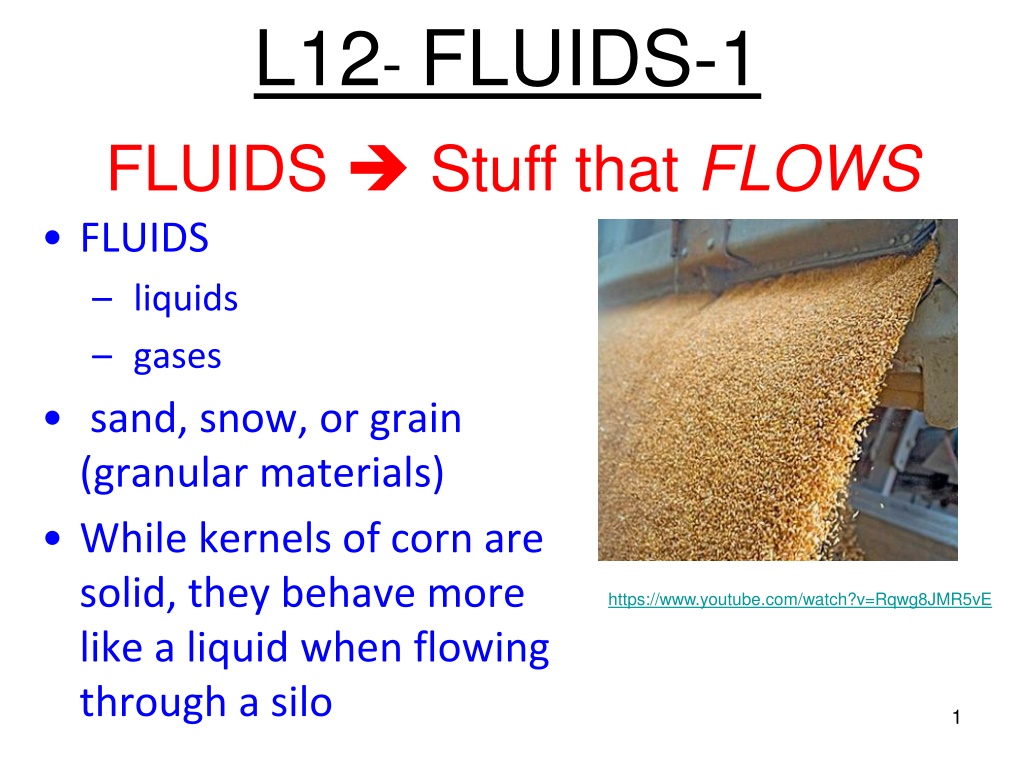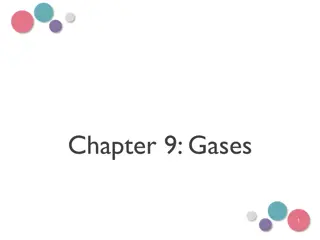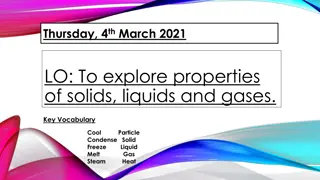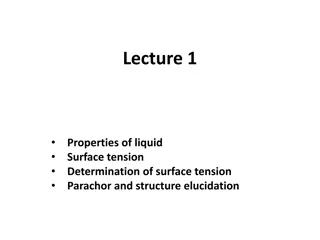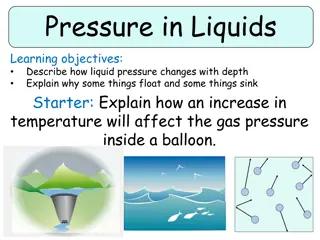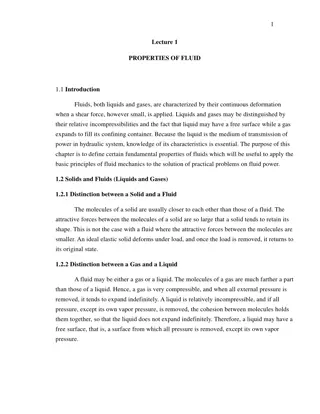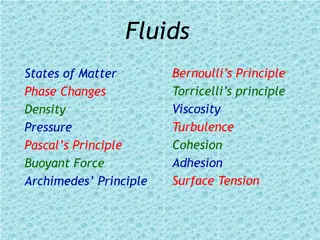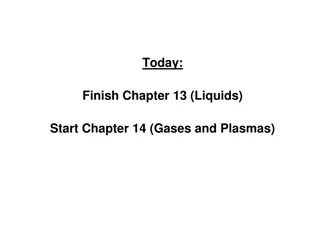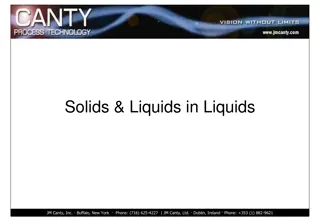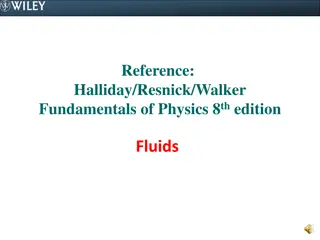Understanding Matter: Solids, Liquids, Gases, and Fluids
Matter exists in various states - solid, liquid, gas, and fluid. Solids have atoms closely packed, liquids have more freedom but still cohesion, gases have atoms spread out, and fluids flow like liquids or gases. Mass density characterizes matter based on atom proximity. Gas pressure results from molecules colliding with container walls. Atoms form the basic unit of matter in the atomic hypothesis. Explore the differences between solids, liquids, and gases.
Download Presentation

Please find below an Image/Link to download the presentation.
The content on the website is provided AS IS for your information and personal use only. It may not be sold, licensed, or shared on other websites without obtaining consent from the author. Download presentation by click this link. If you encounter any issues during the download, it is possible that the publisher has removed the file from their server.
E N D
Presentation Transcript
L12- FLUIDS-1 FLUIDS Stuff that FLOWS FLUIDS liquids gases sand, snow, or grain (granular materials) While kernels of corn are solid, they behave more like a liquid when flowing through a silo https://www.youtube.com/watch?v=Rqwg8JMR5vE https://www.youtube.com/watch?v=Rqwg8JMR5vE 1
States of Matter Comes in three states solid, liquid, gas So far we have only dealt with solid objects blocks, sticks, balls, etc. The study of fluids is more complicated because fluids are complicated since they do not have any particular shape Fluids are not rigid bodies But, Newton s laws can be applied to fluids 2
Atoms the basic pieces of stuff All matter is composed of atoms (atomic hypothesis) If we imagine cutting an object into smaller and smaller pieces, we eventually get down to atoms Diameter about 10-10 m Acceptance of the atomic hypothesis evolved over about a century 1800-1900 3
Differences between solids, liquids and gases 1. The main difference is the distance between the atoms The atoms of a solid are closer to each other than the atoms in a liquid the atoms in a liquid are closer to each other than the atoms in a gas, and 2. The strength of the forces between the atoms. The forces between atoms in a solid are stronger than the forces between atoms in a liquid The forces between atoms in a liquid are stronger than the forces between atoms in a gas 4 SOLID LIQUID GAS
Mass Density (, Greek rho) Density is one way to characterize matter it depends on how close the atoms are to each other The mass density is the amount of mass in a unit volume of the substance It is measured in kilograms per cubic meter (kg/m3) or g/cm3 (g/cc) = 1000 kg/m3 1 m One cubic meter 1 kg 1 m 1 m 5
A few mass densities Substance lead Density (kg / m3) 11,000 water air aluminum 1,000 1.25 2,700 iron 2,300 mercury 13,600 6
Gases: air pressure The average effect of many, many molecules hitting the walls produces a force on the wall The size of this force depends on the surface area of the wall which depends on the container It makes more sense to give the force on a unit surface --- PRESSURE The air molecules (oxygen and nitrogen) in the box bounce around in all directions When they hit the wall they give it an impulse 7
Definition of pressure Pressure = force per unit area P = force / area = F / A The unit of pressure is Newtons per m2 One N/m2 is called one Pascal (Pa) Another commonly used unit is pounds per square inch (psi). These are the units on a typical tire pressure gauge 8
The pressure in a gas The more molecules in the box (the number per unit volume) the larger the pressure The pressure of a gas is also larger if the molecules have larger speeds (faster) At a higher temperature the molecules have more energy and thus higher speeds Thus the pressure depends on 2 factors: pressure number density x temperature Ideal gas law proportional to 9
The Earths atmosphere atmosphere The atmosphere is a thin layer of air surrounding the earth It extends upward to about 6 miles It is held in place by gravity. The moon has no atmosphere because its gravity is not strong enough to hold on to one If the earth were a basketball, the atmosphere would be the thickness of a sheet of paper. 10
Atmospheric pressure At the earth s surface the pressure due to the atmosphere is about 100,000 N/m2 (105 N/m2) or just 1 atmosphere (atm) units: 1 N/m2 = 1 Pa (Pascal) This means that over a 1 square meter of surface area the atmosphere exerts a force of 100,000 N/m2 x 1 m2 = 100,000 N This amounts to about 22,500 lbs or 11 tons! This corresponds to a mass of 10,000 kg Why don t we seem to notice this force? 11
The power of atmospheric pressure We typically do not feel atmospheric pressure because it is the same on all sides (inside and outside) of objects. For example, the pressure is the same on both sides of a window. The pressure inside our bodies is the same as the pressure outside. You feel atmospheric pressure on your eardrums when you go up a mountain or an elevator to the top of a tall building. 12
Magdeburg hemispheres In 1654 two teams of horses try to separate the halves of a sphere with the air pumped out. When under vacuum there is about 1 ton of force holding the hemisphere s together 13
Atmospheric pressure in action When the air is removed from inside the gas can, atmospheric pressure on the outside is unbalanced and crushes the can. Suction cups also use atmospheric pressure to hold things together. Vacuum pump 1 US Gallon 14
LIQUIDS Liquids cannot support themselves one layer of a fluid cannot exert a shear force (sidewise)to prevent slipping Liquids must have a container 15
Variation of pressure with depth in a liquid Anybody the does scuba diving knows that the pressure increases as you dive to greater depths The increasing water pressure with depth limits how deep a submarine can go crush depth about 2400 ft for the US Seawolf class subs, 4000 ft for titanium soviet subs. 16
The deeper you go, the higher the pressure The hypothetical volume of liquid of volume A x h is at rest Thus, the net force on this volume must = 0 Fbottom = Ftop + W Therefore: Fbottom must be greater than Ftop The pressure on the bottom is higher than pressure on top Pressure increases with depth Patm PtopA A h W PbottomA Force = Pressure x Area F = P A 17
How much does P increase with depth? P(h) = Patm + g h where is the density of the liquid (kg/m3) At the surface of a body of water the pressure is 1 atm = 100,000 Pa Example: As we go down into the water, at what depth does the pressure double, from 1 atm (100,000 Pa) to 2 atm (200,000 Pa)? P(h) = 200,000 Pa = 100,000 Pa + g h g h = 100,000 Pa = 1000 (kg/m3)x 10 (m/s2) x h (m) h = 10 m, or roughly 32 feet. 100,000 Pa h P(h) 18
Why does pressure increase with depth? this layer of fluid must support all the fluid above it the block on the bottom supports all the blocks above it Put simply, the deeper you go, the more water you have pushing down on you from above. 19
Measuring atmospheric pressure - Barometers Inverted closed tube filled with liquid The column of liquid is held up by the pressure of the liquid in the tank. Near the surface this pressure is atmospheric pressure, so the atmosphere holds the liquid up. PATM PATM Pliquid 20
Barometric pressure Atmospheric pressure can support a column of water 10.3 m high, or a column of mercury (which is 13.6 times as dense as water) 30 inches high the mercury barometer Today s weather 21
Pascals Vases The fluid levels are the same in all each tube, regardless of their shape 22
